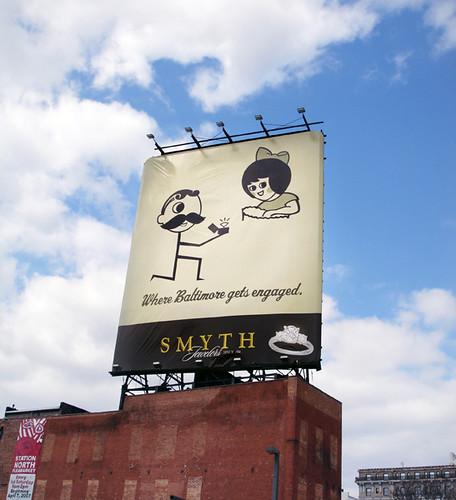Centre Theater
10 E. North Avenue
Baltimore, Maryland 21218
The Centre Theater opened its doors
on February 2nd, 1939 as the latest addition to Baltimore’s theater
community. The complex was originally deemed “Radio Centre” for it also
included a radio station for WFBR, as well as offices for the Equitable Trust
Company, a shop, and a parking garage. Prior to its construction, the lot at 10
East North Avenue was used as a Studebaker and Chevrolet car dealership, a
similar industry that was commonly found on North Howard Street (Kelly, 2014). The
Centre is located in Station North Arts and Entertainment District on the first
block of east North Avenue on the north side of the street. Currently, the
complex is being restored to become a mixed-use development that will centralize
history, arts and community in Station North.
The theater came to fruition thanks
to Morris A. Mechanic, a local developer who would later be the namesake of the
late brutalist 1967 Mechanic Theater in Downtown Baltimore (Chan, 2011). Mechanic
came from a Polish and Jewish background, who immigrated to Baltimore as a
child. A true businessman, Mechanic began his success by owning a chocolate
shop downtown while being a principle for Hebrew School in West Baltimore
(Pousson). Ten years prior to the opening of The Centre, Mechanic purchased The
New Theatre at 210 West Lexington Street on the Westside, which became a major
success with its showing of Sunny Side Up
(Kilduff). This success drove Mechanic to continue his theater business until
his death in July of 1966 (Pousson).
The theater presents a rich history for
its precedence in the arts and for its architectural significance. A few days
before opening night, the Baltimore Sun described the new art deco style as
“conservatively modern”. The architect, Armand Carroll, expressed that the
style was meant to be utilitarian and that the decoration was “intended to
soothe rather than startle the spectator” (The Sun, 1939). The sheer smooth
angles of the theater’s façade still attract the passerby’s eye as they
traverse North Avenue. The theater also is significant for it was the first
theatre in the city equipped for radio broadcasting and the ability to project
live television on the screen (Kelly, 2014).
Within its interior, the theater
also was acclaimed for a circular proscenium arch outfitted with multicolor
light bulbs and gold leaf paint. The main stage of the theater was a modest
size, but was equipped with the latest technology for either film or theater
events. The theater itself seated up to 1,000 guests, and was one of the first
in the city to be climate controlled. On the opening night, Mayor Howard W.
Jackson along with major players in the film and broadcasting industry joined
Baltimore’s socialites to view the Baltimore’s first aviation film: Tailspin (The Sun, 1939). Many memorable
films were shown at The Centre, including the Baltimore premiers of Oklahoma, and Around the World in 80 Days in 1956 (“Center Theatre”).
Unfortunately, The Centre’s crowds
were dwindling as Station North decayed due to suburbanization and white
flight. In response to the declining admissions, the lobby was also used as a
gallery space for artists Jacob Glushakow and Herman Maril (Kelly, 2014). The
Centre continued to operate as a film and radio center until April 16, 1959
when the neighboring Equitable Trust Company expanded its office space into the
structure. Redevelopment plans included adding an additional story to the
existing theater, due to there being 20,000 square feet of unusable space on each
level of the theater (The Sun, 1958). A major reason for the banks expansion
was the need for new space to house state-of-the-art electronic equipment that
was highly sensitive. Despite the closing of the theater, WFBR continued its
operations under a lease with the bank. During the 1970s, WFBR became locally
renowned for their disc jockey, Johnny Walker, who operated out of the leased
space. Later on, the space was also used as a church for the community, but
soon became vacant and dilapidated (Kelly, 2014).
In 2002, Station North Arts and
Entertainment District was formed by the city government, creating hope for the
old abandoned North Avenue theaters. Along with this designation, the National
Register of Historic Places created the North Central Historic District,
protecting the Centre Theater from deliberate destruction. However, it wasn’t
until July of 2011 when Charles Duff, the president of the nonprofit
organization Jubilee Baltimore, purchased The Centre at a public auction for
the price of $93,000 (Kelly, 2014). Duff is leading the efforts to redevelop
and restore the property to its former glory, so that it once again can
contribute to the entertainment industry of Baltimore.
The new theater will be the new facility
for film and video programs derived out of the partnership between the Johns
Hopkins University in Homewood and the Maryland Institute College of Art (MICA)
in Bolton Hill (Kelly, 2014). Together with Jubilee Baltimore, Ziger/Snead and
Southway Builders are leading the reconstruction process. The completed 73,000
square foot Centre Theater will feature spaces for film screenings, music
venues, artists’ studios, galleries, a playhouse and a restaurant (“10 East
North”). The project was awarded $3 million in Maryland Sustainable Tax Credits,
and was required to follow environmental and historical design standards.
Construction for The Centre began in late 2013, and is expected to open in
March 2015 (Meehan, 2013).








